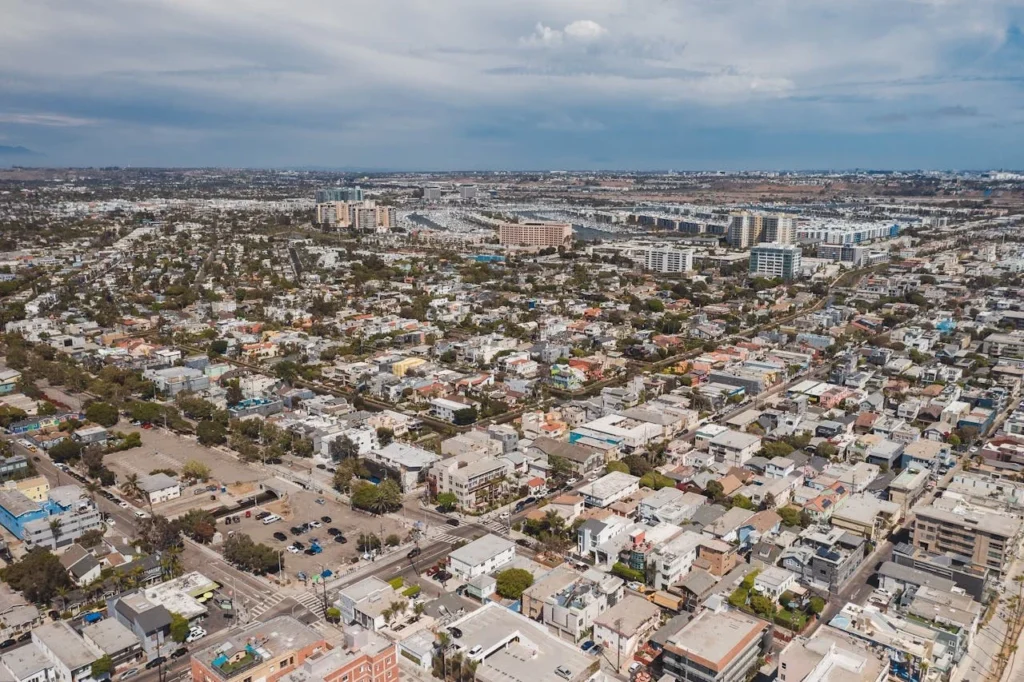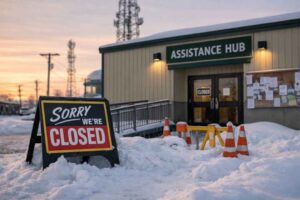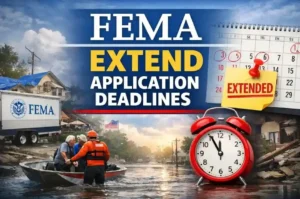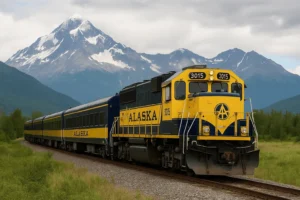Alaska, the “Last Frontier,” is renowned for its breathtaking natural landscapes and rugged wilderness. But beyond the glaciers and mountains lies a fascinating story waiting to be told – the story of Alaska’s population.
Examining the population of Alaska and trends isn’t just about numbers; it’s about the state’s future. Population shifts can impact everything from infrastructure needs to educational opportunities and healthcare services. By analyzing these trends, policymakers can make informed decisions about resource allocation and economic development, ensuring a sustainable future for Alaska and its residents.
Population of Alaska by Cities in 2023
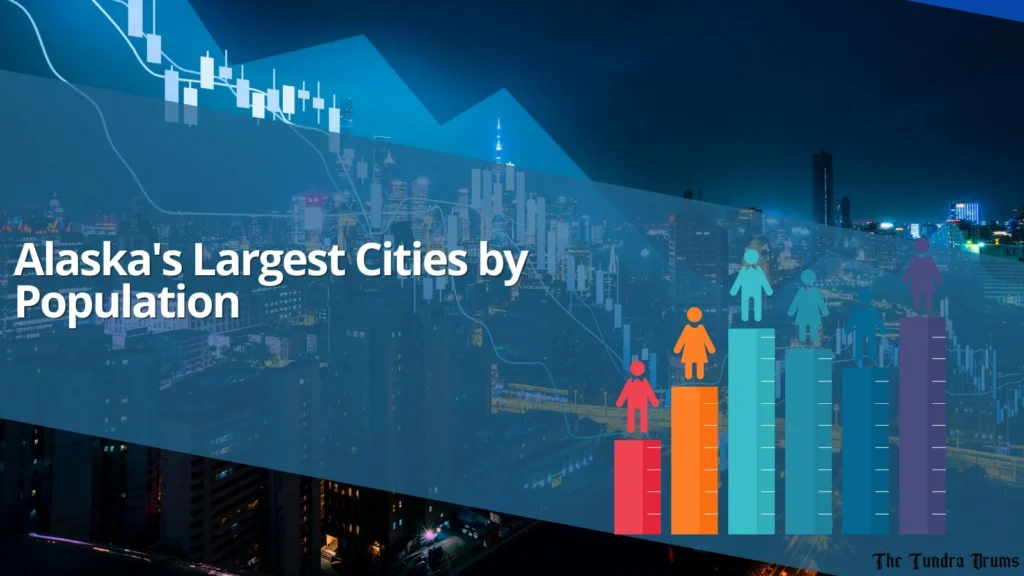
Alaska is a sparsely populated state with most of its residents concentrated in a few urban areas. The largest city and metropolitan area is Anchorage, followed by Fairbanks and Juneau. While these cities have seen some growth in recent years, much of Alaska remains relatively unpopulated due to its vast wilderness and harsh climate.
Here are the approximate Alaska population density of the top five cities as of 2023:
- Anchorage: Approximately 290,000
- Fairbanks: Approximately 32,000
- Juneau: Approximately 32,000
- Ketchikan: Approximately 8,000
- Sitka: Approximately 8,000
Population of Alaska by Cities in 2024
Alaska, a vast state known for its rugged wilderness and extreme climate, is sparsely populated, with most residents concentrated in a few urban centers. Anchorage Alaska population growth rate is followed by Fairbanks and Juneau. While these cities have experienced some growth, Alaska’s vast and often inhospitable terrain limits significant population expansion in many areas.
Here is the Alaska population as of 2024:
- Anchorage: Approximately 284,469
- Fairbanks: Approximately 31,674
- Juneau: Approximately 31,337
- Knik-Fairview: Approximately 19,235
- Badger: Approximately 19,031
Population of Alaska by Cities in 2025
The population of Alaska’s cities in 2025 is estimated using projections from multiple recent sources. The numbers below reflect the most consistent estimates for the largest and most significant cities and communities in Alaska.
Top 10 Most Populated Cities in Alaska (2025)
Rank | City | 2025 Population Estimate |
1 | Anchorage | 282,863 – 288,411 |
2 | Fairbanks | 31,427 – 32,162 |
3 | Juneau | 31,119 – 31,796 |
4 | Badger | 19,033 – 19,434 |
5 | Knik-Fairview | 18,921 – 19,543 |
6 | North Lakes | 12,827 |
7 | College | 12,229 |
8 | Wasilla | 9,700 – 10,501 |
9 | Tanaina | 10,053 |
10 | Meadow Lakes | 9,074 |
Other Notable Cities:
- Sitka: 8,186 – 8,275
- Ketchikan: 8,019 – 8,054
- Kenai: 7,623 – 7,951
- Palmer: 6,310 – 6,673
- Bethel: 6,267 – 6,358
- Kodiak: 5,220 – 5,384
Anchorage remains the largest city by a wide margin, with a population estimated between 282,863 and 288,411 in 2025.
Fairbanks and Juneau are the next largest, each with populations just above 31,000.
The Matanuska-Susitna Valley (including Wasilla, Palmer, and several census-designated places like Knik-Fairview and Badger) continues to see significant growth, with several communities in the 10,000–20,000 range.
Sitka, Ketchikan, Kenai, and Kodiak round out the list of notable population centers, each with between 5,000 and 8,000 residents.
Demographic Breakdown: A Look at Alaska’s Age Spectrum
Alaska’s population boasts a unique age distribution shaped by factors like migration patterns and economic opportunities. Here’s a breakdown of the total population in Alaska by the key age groups:
- Children and Adolescents (0-17 years old): According to the U.S. Census Bureau’s 2022 American Community Survey estimates, roughly 23.2% of Alaska’s population falls within this age range. This translates to approximately 170,000 children and adolescents residing in the state.
- Working-Age Adults (18-64 years old): According to the same ACS data, this segment forms the backbone of Alaska’s workforce, comprising an estimated 62.3% of the population density of Alaska (around 458,000 individuals).
- Senior Citizens (65 years and older): Alaska’s senior population is growing, accounting for approximately 14.5% (around 106,000 residents). This trend aligns with national demographics, reflecting an aging population in the United States.
Geographic Distribution: A Patchwork of Population in Alaska
Alaska’s vastness is reflected in its uneven Alaska population growth rate. Here’s a closer look at how people are spread across the state:
Population Density by Region:
According to the Alaska Department of Labor and Workforce Development, Alaska is the least densely populated state, with an average density of around 1.3 people per square mile. However, this average masks significant regional variations:
- Southcentral Alaska:
- Southeast Alaska:
- Interior and Western Alaska:
This region, home to Anchorage (the state’s largest city with a population of roughly 291,247 as of 2024), Matanuska-Susitna Borough (around 108,317 residents), and Fairbanks (population estimated at 31,856 in 2024), is by far the most densely populated area, containing over half of Alaska’s residents.
This region, known for its stunning island chains and temperate climate, has a more scattered population. Major population centers include Juneau (the state capital with 32,255 residents in 2024) and Ketchikan (around 13,980 residents).
These regions are vast and sparsely populated. Communities like Utqiagvik (formerly Barrow), with around 4,350 residents, and Bethel (population around 6,292) serve as population hubs.
Urban vs. Rural Areas:
The vast majority of Alaskans reside in urban areas. Approximately 66% of the population lives in urban centers, with the remaining 34% scattered across rural regions. This reflects the limited infrastructure and harsh climate conditions in many rural areas.
Major Cities and Towns:
Alaska demographics cities by population (2024 estimates):
#ays-chart-container695787f7c07a3 div.ays-chart-charts-main-container695787f7c07a3 { width: 100%; height: 400px; margin:auto; border-radius: 0px; }#ays-chart-container695787f7c07a3 div.ays-chart-header-container { margin-bottom: 5px !important; }#ays-chart-container695787f7c07a3 div.ays-chart-header-container>.ays-chart-charts-title695787f7c07a3 { color: #000000; font-size: 30px; font-weight: bold; font-style: normal; text-align: left; }#ays-chart-container695787f7c07a3 div.ays-chart-header-container>.ays-chart-charts-description695787f7c07a3 { color: #4c4c4c; font-size: 16px; font-weight: normal; font-style: normal; text-align: left; }#ays-chart-container695787f7c07a3 div.ays-chart-actions-container>div.ays-chart-export-buttons .ays-chart-export-button-695787f7c07a3 { color: #4c4c4cB3 !important; font-size: 16px !important; }#ays-chart-container695787f7c07a3 div.ays-chart-actions-container>div.ays-chart-export-buttons .ays-chart-export-button-695787f7c07a3:hover { color: #4c4c4c !important; }#ays-chart-container695787f7c07a3 .ays-chart-charts-main-container[data-type='org_chart'] table.google-visualization-orgchart-table tbody tr td { padding: initial; } if(typeof aysChartOptions === 'undefined'){ var aysChartOptions = []; } aysChartOptions['695787f7c07a3'] = 'eyJjaGFydF9kYXRhX2J5X3R5cGVzIjpbXSwiY2hhcnRfdHlwZSI6ImxpbmVfY2hhcnQiLCJzb3VyY2UiOltbIkNvdW50cnkiLCJQb3B1bGF0aW9uIl0sWyJBbmNob3JhZ2UiLCIyOTEyNDciXSxbIkZhaXJiYW5rcyIsIjMxODU2Il0sWyJKdW5lYXUiLCIzMjI1NSJdLFsiS25pay1GYWlydmlldyIsIjE5Mjk3Il0sWyJCYWRnZXIiLCIxOTAzMSJdLFsiQ29sbGVnZSIsIjExMzMyIl1dLCJvcHRpb25zIjp7InNob3dfdGl0bGUiOiJvbiIsInNob3dfZGVzY3JpcHRpb24iOiJvbiIsImVuYWJsZV9pbnRlcmFjdGl2aXR5Ijoib24iLCJ0b29sdGlwX3RyaWdnZXIiOiJob3ZlciIsInRvb2x0aXBfdGV4dF9jb2xvciI6IiMwMDAwMDAiLCJ0b29sdGlwX2ZvbnRfc2l6ZSI6IjE1IiwidG9vbHRpcF9ib2xkIjoiZGVmYXVsdCIsImxlZ2VuZF9wb3NpdGlvbiI6InJpZ2h0IiwibGVnZW5kX2FsaWdubWVudCI6InN0YXJ0IiwibGVnZW5kX2NvbG9yIjoiIzAwMDAwMCIsImxlZ2VuZF9mb250X3NpemUiOiIxNSIsImhheGlzX3RpdGxlIjoiIiwiaGF4aXNfbGFiZWxfZm9udF9zaXplIjoiMTUiLCJoYXhpc19sYWJlbF9jb2xvciI6IiMwMDAwMDAiLCJoYXhpc190ZXh0X3Bvc2l0aW9uIjoib3V0IiwiaGF4aXNfdGV4dF9jb2xvciI6IiMwMDAwMDAiLCJoYXhpc190ZXh0X2ZvbnRfc2l6ZSI6MTUsImhheGlzX3NsYW50ZWQiOiJhdXRvbWF0aWMiLCJoYXhpc19zbGFudGVkX3RleHRfYW5nbGUiOiIzMCIsImhheGlzX2Zvcm1hdCI6IiIsImhheGlzX21heF92YWx1ZSI6bnVsbCwiaGF4aXNfbWluX3ZhbHVlIjpudWxsLCJoYXhpc19ncmlkbGluZXNfY291bnQiOiItMSIsImhheGlzX2dyaWRsaW5lc19jb2xvciI6IiNjY2NjY2MiLCJoYXhpc19taW5vcl9ncmlkbGluZXNfY29sb3IiOiIjY2NjY2NjIiwiaGF4aXNfYmFzZWxpbmVfY29sb3IiOiIjMDAwMDAwIiwiaGF4aXNfc2hvd190ZXh0X2V2ZXJ5IjoiMCIsInZheGlzX3RpdGxlIjoiIiwidmF4aXNfbGFiZWxfZm9udF9zaXplIjoiMTUiLCJ2YXhpc19sYWJlbF9jb2xvciI6IiMwMDAwMDAiLCJ2YXhpc190ZXh0X3Bvc2l0aW9uIjoib3V0IiwidmF4aXNfdGV4dF9jb2xvciI6IiMwMDAwMDAiLCJ2YXhpc190ZXh0X2ZvbnRfc2l6ZSI6MTUsInZheGlzX2Zvcm1hdCI6IiIsInZheGlzX21heF92YWx1ZSI6bnVsbCwidmF4aXNfbWluX3ZhbHVlIjpudWxsLCJ2YXhpc19ncmlkbGluZXNfY291bnQiOiItMSIsInZheGlzX2dyaWRsaW5lc19jb2xvciI6IiNjY2NjY2MiLCJ2YXhpc19taW5vcl9ncmlkbGluZXNfY29sb3IiOiIjY2NjY2NjIiwidmF4aXNfYmFzZWxpbmVfY29sb3IiOiIjMDAwMDAwIiwiYW5pbWF0aW9uX2R1cmF0aW9uIjoxMDAwLCJhbmltYXRpb25fc3RhcnR1cCI6Im9uIiwiYW5pbWF0aW9uX2Vhc2luZyI6ImxpbmVhciIsImxpdmVfY2hhcnRfaW50ZXJ2YWwiOiIzMDAwIiwid2lkdGgiOiIxMDAiLCJ3aWR0aF9mb3JtYXQiOiIlIiwicG9zaXRpb24iOiJjZW50ZXIiLCJoZWlnaHQiOiI0MDAiLCJoZWlnaHRfZm9ybWF0IjoicHgiLCJmb250X3NpemUiOiIxNSIsIm9yZ19jaGFydF9mb250X3NpemUiOiJtZWRpdW0iLCJiYWNrZ3JvdW5kX2NvbG9yIjoiI2ZmZmZmZiIsImJvcmRlcl93aWR0aCI6IjAiLCJib3JkZXJfY29sb3IiOiIjNjY2NjY2IiwiYm9yZGVyX3JhZGl1cyI6IjAiLCJjaGFydF9iYWNrZ3JvdW5kX2NvbG9yIjoiI2ZmZmZmZiIsImNoYXJ0X2JvcmRlcl93aWR0aCI6IjAiLCJjaGFydF9ib3JkZXJfY29sb3IiOiIjNjY2NjY2IiwiY2hhcnRfbGVmdF9tYXJnaW4iOiIiLCJjaGFydF9yaWdodF9tYXJnaW4iOiIiLCJjaGFydF90b3BfbWFyZ2luIjoiIiwiY2hhcnRfYm90dG9tX21hcmdpbiI6IiIsInRpdGxlX2NvbG9yIjoiIzAwMDAwMCIsInRpdGxlX2ZvbnRfc2l6ZSI6IjMwIiwidGl0bGVfYm9sZCI6Im9uIiwidGl0bGVfcG9zaXRpb24iOiJsZWZ0IiwidGl0bGVfZ2FwIjoiNSIsImRlc2NyaXB0aW9uX2NvbG9yIjoiIzRjNGM0YyIsImRlc2NyaXB0aW9uX2ZvbnRfc2l6ZSI6IjE2IiwiZGVzY3JpcHRpb25fcG9zaXRpb24iOiJsZWZ0Iiwicm90YXRpb25fZGVncmVlIjoiMCIsInNsaWNlX2JvcmRlcl9jb2xvciI6IiNmZmZmZmYiLCJzbGljZV90ZXh0IjoicGVyY2VudGFnZSIsInRvb2x0aXBfdGV4dCI6ImJvdGgiLCJkYXRhX2dyb3VwaW5nX2xpbWl0IjoiMC41IiwiZGF0YV9ncm91cGluZ19sYWJlbCI6Ik90aGVyIiwiZGF0YV9ncm91cGluZ19jb2xvciI6IiMwMDAwMDAiLCJmb2N1c190YXJnZXQiOiJkYXR1bSIsIm9wYWNpdHkiOiIxLjAiLCJncm91cF93aWR0aCI6IjYxLjgiLCJncm91cF93aWR0aF9mb3JtYXQiOiIlIiwibGluZV93aWR0aCI6IjIiLCJtdWx0aXBsZV9kYXRhX2Zvcm1hdCI6ImF1dG8iLCJwb2ludF9zaGFwZSI6ImNpcmNsZSIsInBvaW50X3NpemUiOjAsImNyb3NzaGFpcl90cmlnZ2VyIjoibm9uZSIsImNyb3NzaGFpcl9vcmllbnRhdGlvbiI6ImJvdGgiLCJjcm9zc2hhaXJfb3BhY2l0eSI6IjEuMCIsImRvbnV0X2hvbGVfc2l6ZSI6IjAuNCIsImxpbmVfY3VydmVfdHlwZSI6IlN0cmFpZ2h0Iiwib3JnX25vZGVfZGVzY3JpcHRpb25fZm9udF9jb2xvciI6IiNmZjAwMDAiLCJvcmdfbm9kZV9kZXNjcmlwdGlvbl9mb250X3NpemUiOiIxMyIsIm9yZ19jbGFzc25hbWUiOiIiLCJvcmdfbm9kZV9iYWNrZ3JvdW5kX2NvbG9yIjoiI2VkZjdmZiIsIm9yZ19ub2RlX3BhZGRpbmciOiIyIiwib3JnX25vZGVfYm9yZGVyX3JhZGl1cyI6IjUiLCJvcmdfbm9kZV9ib3JkZXJfd2lkdGgiOiIwIiwib3JnX25vZGVfYm9yZGVyX2NvbG9yIjoiI2I1ZDllYSIsIm9yZ19ub2RlX3RleHRfY29sb3IiOiIjMDAwMDAwIiwib3JnX25vZGVfdGV4dF9mb250X3NpemUiOiIxMyIsInNsaWNlX2NvbG9yIjpbIiMzMzY2Y2MiLCIjZGMzOTEyIiwiI2ZmOTkwMCIsIiMxMDk2MTgiLCIjOTkwMDk5Il0sInNsaWNlX29mZnNldCI6WyIwIiwiMCIsIjAiLCIwIiwiMCJdLCJzbGljZV90ZXh0X2NvbG9yIjpbIiNmZmZmZmYiLCIjZmZmZmZmIiwiI2ZmZmZmZiIsIiNmZmZmZmYiLCIjZmZmZmZmIl0sInNlcmllc19jb2xvciI6WyIjMzM2NmNjIl0sInNlcmllc192aXNpYmxlX2luX2xlZ2VuZCI6WyJvbiJdLCJzZXJpZXNfbGluZV93aWR0aCI6IltcIjJcIl0iLCJzZXJpZXNfcG9pbnRfc2l6ZSI6IltcIjBcIl0iLCJzZXJpZXNfcG9pbnRfc2hhcGUiOiJbXCJjaXJjbGVcIl0iLCJlbmFibGVfcm93X3NldHRpbmdzIjoib24iLCJyb3dzX2NvbG9yIjpbIiMzMzY2Y2MiLCIjMzM2NmNjIiwiIzMzNjZjYyIsIiMzMzY2Y2MiLCIjMzM2NmNjIiwiIzMzNjZjYyJdLCJyb3dzX29wYWNpdHkiOlsiMSIsIjEiLCIxIiwiMSIsIjEiLCIxIl0sInJlc3BvbnNpdmVfd2lkdGgiOiJvZmYiLCJ0cmFuc3BhcmVudF9iYWNrZ3JvdW5kIjoib2ZmIiwic2hvd19jb2xvcl9jb2RlIjoib2ZmIiwidG9vbHRpcF9pdGFsaWMiOiJvZmYiLCJsZWdlbmRfaXRhbGljIjoib2ZmIiwibGVnZW5kX2JvbGQiOiJvZmYiLCJoYXhpc19pdGFsaWMiOiJvZmYiLCJoYXhpc19ib2xkIjoib2ZmIiwidmF4aXNfaXRhbGljIjoib2ZmIiwidmF4aXNfYm9sZCI6Im9mZiIsInJldmVyc2VfY2F0ZWdvcmllcyI6Im9mZiIsImhheGlzX3RpdGxlX2l0YWxpYyI6Im9mZiIsImhheGlzX3RpdGxlX2JvbGQiOiJvZmYiLCJ2YXhpc190aXRsZV9pdGFsaWMiOiJvZmYiLCJ2YXhpc190aXRsZV9ib2xkIjoib2ZmIiwiaXNfc3RhY2tlZCI6Im9mZiIsIm11bHRpcGxlX3NlbGVjdGlvbiI6Im9mZiIsInRpdGxlX2l0YWxpYyI6Im9mZiIsImRlc2NyaXB0aW9uX2JvbGQiOiJvZmYiLCJkZXNjcmlwdGlvbl9pdGFsaWMiOiJvZmYiLCJtYXhpbWl6ZWRfdmlldyI6Im9mZiIsImhheGlzX2RpcmVjdGlvbiI6IjEiLCJ2YXhpc19kaXJlY3Rpb24iOiIxIiwiZW5hYmxlX2FuaW1hdGlvbiI6Im9mZiIsIm9yaWVudGF0aW9uIjoib2ZmIiwiZmlsbF9udWxscyI6Im9mZiIsImFsbG93X2NvbGxhcHNlIjoib2ZmIiwiZW5hYmxlX2ltZyI6Im9mZiIsImNoYXJ0X2xlZnRfbWFyZ2luX2Zvcl9qcyI6ImF1dG8iLCJjaGFydF9yaWdodF9tYXJnaW5fZm9yX2pzIjoiYXV0byIsImNoYXJ0X3RvcF9tYXJnaW5fZm9yX2pzIjoiYXV0byIsImNoYXJ0X2JvdHRvbV9tYXJnaW5fZm9yX2pzIjoiYXV0byIsInNob3dfc2NhbGUiOiJvZmYiLCJtaW5fY29sb3IiOiIjZGQwMDAwIiwibWF4X2NvbG9yIjoiIzAwZGQwMCIsIm1heF9mb250X3NpemUiOjE2LCJzYW5rZXlfbGlua19jb2xvciI6IiNCOEI4QjgiLCJzYW5rZXlfYm9yZGVyX2NvbG9yIjoiI0I4QjhCOCIsInNhbmtleV9ib3JkZXJfd2lkdGgiOjAsInBlcmNlbnRfZW5hYmxlZCI6Im9uIiwic2hvd19yb3dfbGFiZWxzIjoib24iLCJ0aW1lbGluZV9zaW5nbGVfY29sb3IiOiJvZmYiLCJ0aW1lbGluZV9jb2xvciI6IiM0Mjg1RjQiLCJtaW5vcl90aWNrcyI6Miwia2VlcF9hc3BlY3RfcmF0aW8iOiJvbiIsInNob3dfcm93X251bWJlciI6Im9mZiIsInNvcnRfY29sdW1uX2luZGV4IjotMSwiZW5hYmxlX2xpdmVfY2hhcnQiOiJvZmYiLCJlbmFibGVfcHJpbnQiOiJvZmYiLCJlbmFibGVfZXhjZWwiOiJvZmYiLCJlbmFibGVfY3N2Ijoib2ZmIiwiZW5hYmxlX2NvcHkiOiJvZmYiLCJzbGljZV9jb2xvcnNfZGVmYXVsdCI6WyIjMzM2NmNjIiwiI2RjMzkxMiIsIiNmZjk5MDAiLCIjMTA5NjE4IiwiIzk5MDA5OSIsIiMwMDk5YzYiLCIjZGQ0NDc3IiwiIzY2YWEwMCIsIiNiODJlMmUiLCIjMzE2Mzk1IiwiIzk5NDQ5OSIsIiMyMmFhOTkiLCIjYWFhYTExIiwiIzY2MzNjYyIsIiNlNjczMDAiLCIjOGIwNzA3IiwiIzY1MTA2NyIsIiMzMjkyNjIiLCIjNTU3NGE2IiwiIzNiM2VhYyIsIiNiNzczMjIiLCIjMTZkNjIwIiwiI2I5MTM4MyIsIiNmNDM1OWUiLCIjOWM1OTM1IiwiI2E5YzQxMyIsIiMyYTc3OGQiLCIjNjY4ZDFjIiwiI2JlYTQxMyIsIiMwYzU5MjIiLCIjNzQzNDExIl0sInNlcmllc19jb2xvcnNfZGVmYXVsdCI6WyIjMzM2NmNjIiwiI2RjMzkxMiIsIiNmZjk5MDAiLCIjMTA5NjE4IiwiIzk5MDA5OSIsIiMwMDk5YzYiLCIjZGQ0NDc3IiwiIzY2YWEwMCIsIiNiODJlMmUiLCIjMzE2Mzk1IiwiIzk5NDQ5OSIsIiMyMmFhOTkiLCIjYWFhYTExIiwiIzY2MzNjYyIsIiNlNjczMDAiLCIjOGIwNzA3IiwiIzY1MTA2NyIsIiMzMjkyNjIiLCIjNTU3NGE2IiwiIzNiM2VhYyIsIiNiNzczMjIiLCIjMTZkNjIwIiwiI2I5MTM4MyIsIiNmNDM1OWUiLCIjOWM1OTM1IiwiI2E5YzQxMyIsIiMyYTc3OGQiLCIjNjY4ZDFjIiwiI2JlYTQxMyIsIiMwYzU5MjIiLCIjNzQzNDExIl0sImNvbWJvX3R5cGVzIjp7ImxpbmUiOiJMaW5lIiwiYmFycyI6IkJhciIsImFyZWEiOiJBcmVhIiwic3RlcHBlZEFyZWEiOiJTdGVwcGVkIEFyZWEifSwiY29tYm9fdHlwZSI6WyJsaW5lIl19LCJpZCI6NH0=';
Economic Influences on Population
Alaska’s economy, heavily reliant on natural resources and federal spending, significantly shapes Alaska’s population growth. Here’s a breakdown of key economic sectors and their influence on residents:
Impact of the Oil Industry:
- Historically, the oil industry has been a significant driver of Alaska population trends. The construction of the Trans-Alaska Pipeline and subsequent oil booms in the 1970s and 1980s attracted a wave of workers to the state, particularly to urban centers like Anchorage and Fairbanks.
- However, recent years have seen a decline in oil production and exploration. This has led to job losses and a slowdown in population growth, particularly in areas heavily reliant on the industry.
Tourism and Its Effects:
- Tourism is a growing sector in Alaska, attracting visitors with its natural beauty and unique experiences. This sector creates hospitality, transportation, and recreation jobs, contributing to population growth in Southeast Alaska with its cruise industry and national parks.
- However, the tourism industry is seasonal, leading to fluctuations in employment and potentially impacting long-term population stability.
Fishing and Maritime Industries:
- Alaska’s vast coastline and rich marine resources support a thriving fishing industry. While not as dominant as oil in terms of population impact, it provides jobs in coastal communities like Kodiak and Dutch Harbor.
- Similar to tourism, the fishing industry can be seasonal, influencing population fluctuations in some areas.
Military Presence and Its Demographic Impact:
- Alaska has a significant military presence, with major bases like Joint Base Elmendorf-Richardson near Anchorage. Military personnel and their families contribute to the population of surrounding communities.
- However, military deployments and reassignments can lead to population fluctuations in areas with large bases.
Overall
Alaska’s population is sensitive to the booms and busts of its key economic sectors. While the oil industry historically played a dominant role, diversification towards tourism and other sectors offers opportunities for more stable population growth in the future. Understanding these economic influences is crucial for planning infrastructure and social services and ensuring a sustainable future for Alaska’s unique demographic environment.
FAQs
740,133 .
6,267.
| City | Rank | 2025 Pop. ↓ |
|---|---|---|
| Anchorage | 1 | 282,863 |
| Fairbanks | 2 | 31,492 |
| Juneau | 3 | 31,119 |
| Badger | 4 | 19,033 |
Main factors affecting Alaska’s population growth: Economic opportunities, natural resource availability, migration patterns, and birth/death rates influence Alaska’s population growth.
Population distribution across different regions of Alaska: Population is concentrated in urban areas like Anchorage, with vast rural regions remaining sparsely populated.
Economic impacts on population trends in Alaska: Fluctuations in the oil industry and job availability significantly affect migration patterns and overall population stability.
Climate change’s expected influence on Alaska’s population: Climate change may lead to increased migration, displacement, and changes in economic activities, affecting population dynamics.
Role of government policies in shaping Alaska’s demographic landscape: Policies related to resource management, economic development, and social services play a crucial role in influencing population distribution and growth.






